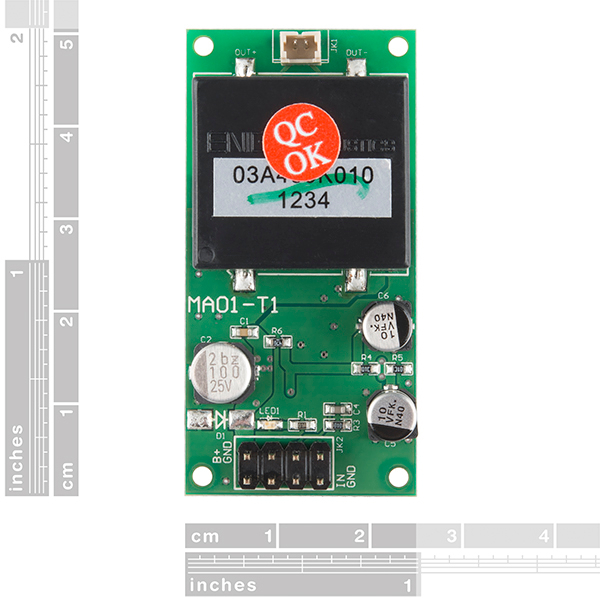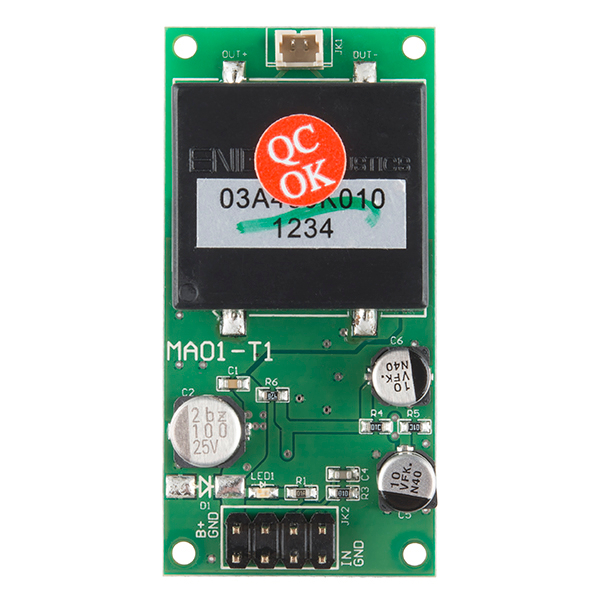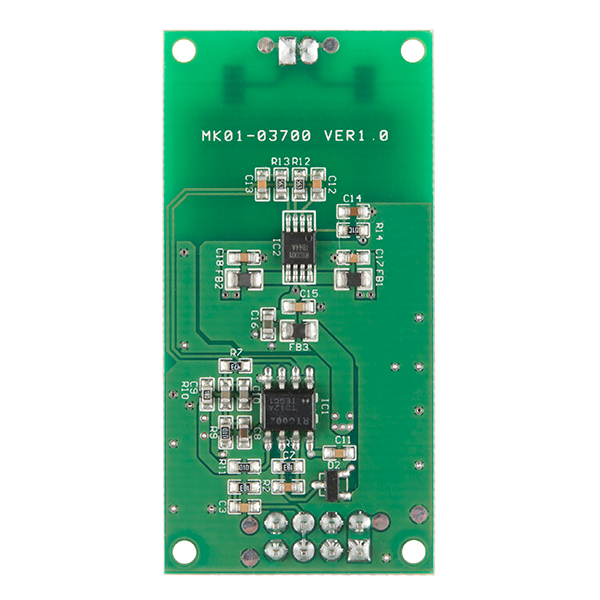×
SparkFun will be closed on Tuesday, December 24th, and Wednesday, December 25th, in observance of the Christmas holiday. Any orders qualifying for same day shipping placed after 2:00 p.m. (MST) on Monday, December 23rd, will be processed on Thursday, December 26th, when we return to regular business hours. Wishing you a safe and happy holiday from all of us at SparkFun!
Please note - we will not be available for Local Pick up orders from December 24th-December 27th. If you place an order for Local Pick-Up we will have those ready on Monday, December 30th.
Flexible Speaker and Amplifier - 7x12cm
This is a very thin flexible speaker with included amplifier, perfect for wearable applications where you need a little sound to spice things up. Each flexible speaker is only a little larger than your average cell phone and all power and connections to your media device are run through the included amp board.
This speaker / amp combo offers an operating voltage of 3-5V, an amp output of 2W, a frequency range of 500~20k, and a max SPL of 85dB. Though this isn't a particularly powerful speaker, the applications in which it can be used are unique to this combo.
- Amp: 1.9 x 0.9" (50 x 25.03mm)
- Speaker: 5.3 x 2.7" (136.68 x 69.69mm)
- [Datasheet](https://cdn.sparkfun.com/datasheets/E-Textiles/Other/FlexSpeaker7x12_Rev A.3.pdf)
- [Frequency Response](https://cdn.sparkfun.com/datasheets/E-Textiles/Other/MA01-0712 FR.JPG)
- [No Load Amp Response](http://cdn.sparkfun.com/datasheets/E-Textiles/Other/MA01 FR.pdf)
- Product Video
Flexible Speaker and Amplifier - 7x12cm Product Help and Resources
Core Skill: Electrical Prototyping
If it requires power, you need to know how much, what all the pins do, and how to hook it up. You may need to reference datasheets, schematics, and know the ins and outs of electronics.
Skill Level: Rookie - You may be required to know a bit more about the component, such as orientation, or how to hook it up, in addition to power requirements. You will need to understand polarized components.
See all skill levels
Comments
Looking for answers to technical questions?
We welcome your comments and suggestions below. However, if you are looking for solutions to technical questions please see our Technical Assistance page.
Customer Reviews
No reviews yet.





Hmm. So there can be 86VAC on the exposed output pins of the amp... Up to 48Vac is generally considered safe. Should we warn the less experienced or just let natural selection rule? ;-)
It would be safe to assume the power consumption of this speaker is relatively low because of the low amplitude audio output. A high voltage source on a low power system indicates a very low current draw. The driver circuit should have been engineered to be capable of providing only slightly more current than the speaker will draw at its max power. So, while you may feel a tingle from the high voltage, I don't think the driver is capable of providing a dangerous level of current. Of course without links to data sheets I'm only making assumptions, always take care when working with high voltage.
Anyone else thinking about in-helmet communications? The power is more than adequate, and the flatness would make it simple to fit inside the helmet between your ear and the padding - AND without sacrificing the design integrity of the helmet (as a small magnetic speaker bouncing around might!)
Is it Washable? since this is "wearable" technology.... It would be great for real wearable tech so that one would only need to detach the amplifier...
For what it's worth, I think the SPL chart should be done in line with other commercial speakers: SPL at 1 meter driven at 1 watt. It won't be perfect, but at least it'll be comparable to, say, a stereo speaker. Even if you get a reading for say 2KHz so that the ratio can be calculated and extrapolated would be nice.
A FLEXIBLE SPEAKER??!! Mind = BLOWN
Is it sew-able? Can it be sewn into other fabric constructs, like perhaps a hat, scarf, shirt, helmet, etc?
Hi All
I had ordered this flexible speaker to try it out, but unfortunately no info was included as to how to hook it up. Can anyone provide info?
I received the pin out for this speaker from Sparkfun tech. Holding the board in front of you, with speaker connector at top and the amp input at the bottom.
On the top is the speaker output plug. On the bottom you will see b+, GND, IN, GND Those labels indicate what each row does. The first two pins on the left(vertically) are battery voltage The next two pins(vertically) are battery ground The third set(vertically) is audio input and the final fourth set(vertically) is audio ground.
Any chance we can get a pinout for the driver?
So would this be a form of the electrostatic speaker? or does it operate in a different way? You never say what the operation is, something that would probably be important for comparison and use.
I'm not sure. usually an EL speaker has some sort of driver that charges the stators. This doesn't have that. I'm thinking it's more of a piezo speaker.
Ok, but aren't pizo speakers usually minimally flexible and brittle? What is being done here to make it flexible? Oh, and how much of a bend will it tolerate? Will folding it back upon itself cause it to fail? (open one up?)
I think you're talking about PZT (lead, zirconate, titanate) piezos, which are basically ceramic and brittle. However, other materials can be made to be piezoelectric. Kynar is flexible, and can be "polled". Polling is the process of aligning the ions within the material and is performed by heating the material up to its Curie temperature while applying a high electric field.
yeah, I'm not really sure. by definition, and EL speaker should be actively powered. We tore one open but couldn't really determine what was going on. The amp can shock you, and it feels a LOT like and EL inverter shock.
Is this like the 70v audio systems?
Nope. A "70V" speaker system is typically seen in large rooms where there are a whole bunch of speaker cans in the ceiling. Think hotel ballroom where the usage is for PA rather than reinforcing a band/DJ. It is more like a small power distribution or electrical grid like you would find between a power plant and your house. In both cases the current is traded for voltage for transmission. It keeps the wires smaller and line losses are less. Some speakers are made to work with the 70V system but other speakers can work with an appropriate transformer. Typical installs use a special amp that has a 70V out. If you used such an amp with this speaker it would probably make some very melodic smoke.
BTW, nice bow tie.
Now just to make the amplifier flexible too...
Perhaps this article is helpful? Can someone at SFE attach an analog 'scope (or MSO) to the thing and measure the voltage?
Why is it that the perfect gizmo comes out just after I place an order? Coincidence? Hah! It's a conspiracy, I tell you! :-)
will we be able to purchase just the speaker?
so that you can embed speakers in multiple things and move the driver around between them? that could be handy. you can't drive it with a normal amp though.
Any chance of this be offered as just the speaker? I wanna use it with a LilyPad mp3 which already has an amp.
guys, this is NOT your typical 8Ω Ohm speaker! You can not just use a normal amplifier, you need their specific circuit and PCB.
I think it's a high voltage speaker. That big box is a transformer. The same concept of the electroluminescent circuit. They run at ~100V.
yep, you're right. the amp outputs around ~86VAC at full power. you can't use a standard amp to drive this, so the speaker by itself won't do you much good.
is this same as the 100v or 70 volt systems? http://en.wikipedia.org/wiki/Constant-voltage_speaker_system
86V peak-to-peak? or...
VAC is the same as VRMS (Root Mean Square) . To find the Peak from RMS simply multiply by the square root of 2 giving: Vpeak = 86V X sqrt(2) = 122Vp and Vpp = 2 X Vp = 244Vpp
Here is a simple brochure from AARL that explains a little more.